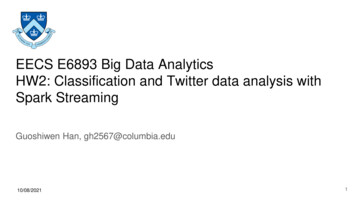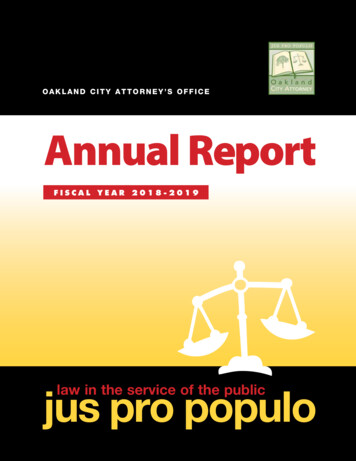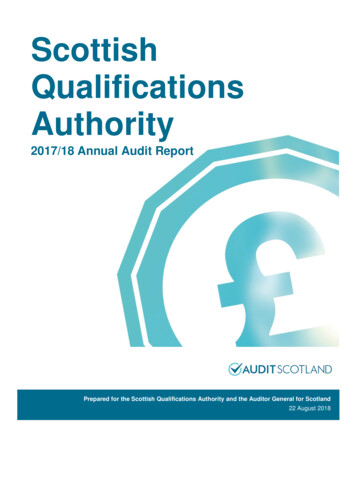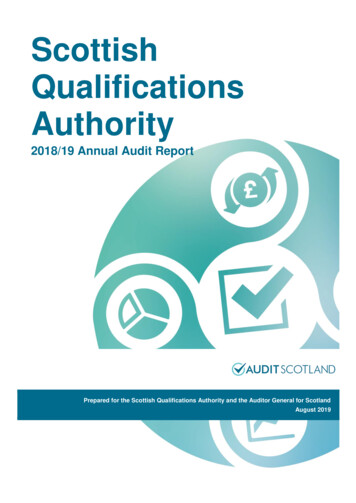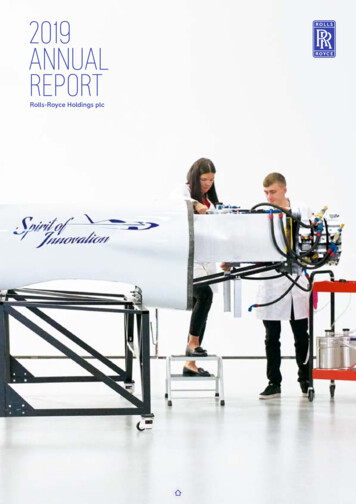
Transcription
ANNUAL REPORT 2018Meet the new faculty membersof the Min H. Kao Department ofElectrical Engineering and Computer Science on Page 6.
CONTENTS1 Department at a Glance2 Awards for 2017-20183 A Message from the Interim Department Head4 EECS Professor and Research Team Develop Potentially Life-Saving Technology6 Fresh Faces: New Faculty10 Grid Cybersecurity- IoT Security in Power System Applications12 Featured Alumnus: Joel Seligstein14 Faculty Spotlight: Dr. Brad Vander Zanden17 EECS Student Organizations20 In the Senior Design Courses, EECS Students Integrate What They Have Learned22 Industry Partners25 Department Profile28 By The Numbers31 Faculty Profile32 EECS Faculty36 Undergraduate Graduates 2017-201837 Masters Graduates 2017-201839 Doctoral Graduates 2017-201840 Join The JourneyOn the Cover: (back row, L-R) Dr. DanWilson, Dr. Amir Sadovnik, Dr. ScottRuoti; (middle row, L-R) Dr. JoshDunn, Dr. Hua (Kevin) Bai, InterimDepartment Head Dr. Greg Peterson;(front row, L-R) Dr. Arun Padakandla,Dr. Austin Henley, Dr. Michela Taufer.41 Give / Stay ConnectedPublished byMin H. Kao Department of Electrical Engineeringand Computer ScienceThe University of TennesseeMin Kao Building1520 Middle Drive, Suite 401Knoxville, TN 37996-2250YouTubeEECS UTKInstagramEECS UTKDesigned and edited byKevin BogleCommunications Specialist IIIFacebookEECS.UTKTwitterEECS UTKEditorial content contributed byKevin Bogle; David Goddard, Xylina Marshall, Leslie Mertz, Dr. MarkDean, Dr. Jinyuan “Stella” Sun, Dr.Jayne WuPhotos contributed byKevin Bogle, Erik Campos, Dana Potter,Joel SeligsteinThe artwork on the inside cover of this publication was created by artist Dana Potter, a graduate student in The University of Tennessee’sSchool of Art. Her artistic interest cultivates inthe exponential integration of technology intodaily life. Four of her art pieces grace the atriumof the Min Kao Building, home of the Min H. KaoDepartment of Electrical Engineering and Computer Science. (art.utk.edu/dana-potter/)
DEPARTMENT AT A GLANCEDEGREES OFFEREDACCREDITATIONBachelor of ScienceElectrical EngineeringComputer EngineeringComputer ScienceAll undergraduate degree programs underthe Department of Electrical Engineeringand Computer Science are accredited byABET.Master of ScienceElectrical EngineeringComputer EngineeringComputer Science2017 ASEE SURVEY DATADoctor of ScienceElectrical EngineeringComputer EngineeringComputer ScienceENROLLMENT FIGURESEnrollment (Full-Time)Academic Year grees GrantedAcademic Year Academic Year 2018-2019ProfessorsAssociate ProfessorsAssistant ProfessorsL e c t u re r sTotal241110449Fall 2018 Freshman EnrollmentComputer ScienceComputer EngineeringElectrical EngineeringTotal EECS Freshmen1207560255 13th nationally among public EECSprograms in research expenditures pertenure-line faculty member. Researchexpenditures grew 66% from FY15 toFY18. 5th nationally among public EECSprograms in Ph.D. enrollment per tenureline faculty member.(Survey data from the American Societyfor Engineering Education)Current Faculty LOWS113NSFCAREERAWARDEESNAIMEMBERSeecs.utk.edu1
DEPARTMENT LEADERSHIPGregory PetersonInterim DepartmentHeadJens GregorAssociate DepartmentHeadExternal Relations andGraduate AffairsHairong QiAssociate DepartmentHeadAcademic AffairsAWARDS FOR 2017-2018Faculty AwardsStudent AwardsDr. Michael BerryCharles and Julie Wharton Teaching Fellow Award, 20182018 The University of Tennessee Chancellor’s Honors:Dr. Josh DunnGraduate Student Senate Excellence in Teaching Award, 2018Dr. Austin HenleyHonorable Mention Award from IEEE VL/HCC, 2017Dr. Fangxing (Fran) LiTCE Faculty Research Fellow, 2018Dr. Garrett RoseTCE Professional Promise in Research Award, 2018Dr. Scott RuotiJohn Karat Usable Privacy And Security Research Award, 2017Dr. Michela TauferJ.P. Morgan Chase Faculty Scholar, 2017-2018Dr. Kevin TomsovicResearch and Creative Achievement Award, University ofTennessee Chancellor’s Honors, 2018Dr. Fred WangIEEE IAS Industrial Power Conversion Systems DepartmentGerald Kliman Innovator Award, 2018TCE Faculty Research Fellow, 2018Paper AwardsBest Paper Award, Qing “Charles” Cao and graduate studentsYunhe Feng and Zheng Lu, “Secure Sharing of Private Locationsthrough Homomorphic Bloom Filters,” 2018 IEEE BigDataSecurity, the 4th IEEE International Conference on Big Data Securityon Cloud, Omaha, NE.Best Oral Paper Presentation Award, Electrical Engineeringgraduate student Frances Garcia, “A SPICE Model for GaN-GateInjection Transistor (GIT) at Room Temperature,” 2018 Connecticut Symposium on Microelectronics & Optoelectronics (CMOC),New Haven, CT.Best Paper Award, Scott Ruoti, “Layering Security at GlobalControl Points to Secure Unmodified Software,” 2017 IEEESecure Development Conference, Boston, MA.2EECS Annual ReportExtraordinary Academic AchievementExtraordinary Academic Achievement honors are awardedto undergraduates who exhibit extraordinary scholarship. Chandler Jackson Bauder Grant BruerExtraordinary Professional PromiseExtraordinary Professional Promise honors are awarded toundergraduate and graduate students who demonstrateprofessional promise in teaching, research or othercontributions. Shaghayegh Aslanzadeh Farnaz Foroughian Mohammad Aminul Haque Ava Hedayatipour Shahram Hatefi Hesari Gerald (J. T.) Liso Ali Mohsin Rania Oueslati Farhan Quaiyum Mohammad Ehsan Raoufat Samira Shamsir Mst Shamim Ara Shawkat Jordan E. Shurmer Farshid Tamjid Taylor Anne WoodwardTop Collegiate Scholar AwardsThe Top Collegiate Scholar Awards honor undergraduateswho exhibit extraordinary scholarship. Grant Richard Bruer Luke Johnston Mills Phuc Tran Hoang Pham Sophie Elizabeth Wardick
A Message from the Interim Department Head2018 is an exciting time forthe Min H. Kao Department ofElectrical Engineering and Computer Science, filled with opportunities and change. The coverphoto of this report shows onenoteworthy update: we haveeight new faculty added to thedepartment starting this fall.Pages 6-9 include brief biographies to introduce each of ournew faculty members.I would like express mydeepest gratitude to Dr. LeonTolbert for his stellar service tothe department as head for theprevious 5½ years, starting inJanuary 2013. The department’sgrowth under his leadership hasbeen phenomenal. As illustratedin the figures on page 29, underhis leadership the number ofEECS undergraduate studentshas grown more than 30% andresearch expenditures haveincreased over 50%. At the endof July, he returned to the faculty to once again pursue hisresearch in power electronics,participate in the CURENT center, and work with students as ateacher, advisor, and mentor.To continue with the themeof change this past year, theTickle College of Engineering’sdean, Dr. Wayne Davis, transitioned to become the interimchancellor for UTK. In his stead,Dr. Lynne Parker of EECS became the interim dean for TCEuntil August, when she becameAssistant Director of ArtificialIntelligence at the White HouseOffice of Science and Technology Policy (OSTP), a particularlyexciting opportunity for her. Atthat point, Dr. Mark Dean became the interim dean for TCE,where he currently serves.The EECS department continues to grow, with undergraduate enrollment growing to 834students in the fall of 2018. Onceagain, the departmental researchexpenditures set a new record,with nearly 23M during FY2018(July 2017 – June 2018). Ourresearch expenditures per tenured/tenure-track faculty exceedthose of our aspirational peers,meaning that our department isamong the most productive inthe country.We highlight the research ofDr. Jayne Wu and the Initiativefor Point Detection and Nanobiosensing (IPN). Her biosensortechnology includes a prototypedevice to help detect diseasesand has recently been licensedfor commercialization.We also explore the cybersecurity research of Dr. Jinyuan“Stella” Sun addressing Internetof Things (IoT) devices deployedin the power grid. These smartdevices promise to providebetter service and reliability, butface challenges to ensure theircorrect operation, even underattack.On page 12, we present ourfeatured alumnus, Joel Seligstein, and his career and accomplishments. Having workedat Facebook and founded aninvestment company, he thencreated the Parallel Plaid gamestudio, while also becoming anOlympic bobsledder.For nearly three decades, Dr.Brad Vander Zanden has beena pillar of the department, providing leadership and passionateteaching to countless computerscience students. In our facultyspotlight on “BVZ,” we sharesome of the impact he has hadthroughout his career.As the culmination of the undergraduate educational experience, the capstone senior design class acts as the “finishingschool” for students who get toapply the theory from throughout their curriculum to a significant team project, along withmany of the practical challengesin working on real-world electrical and computer engineering orcomputer science problems. Weshowcase interesting aspectsof this class and how it helpscomplete the undergraduateeducational experience for ourstudents.On August 1, after 18 years asa professor in EECS and directorof the supercomputing centerat The University of Tennessee,I began serving as the interimhead for EECS. I will seek tobuild on the momentum of thepast 5 years and am particularly excited about our amazingpotential for continued growth.I look forward to working withfaculty, staff, students, and alumni as we strive to maintain theVolunteer spirit of excellence ineducation, research, and service.Best regards,Greg Petersoneecs.utk.edu3
EECS Professor and Research TeamDevelop Potentially Life-SavingTechnologyIt may sound like science fiction - a hand-held device thatcan quickly diagnose diseasesand pathogens in the field - butDr. Jayne Wu, a professor in theMin H. Kao Department of Electrical Engineering and Computer Science at The University ofTennessee, is working to makeit a reality. Dr. Wu, who was recently promoted to full Professor,and Dr. Shigetoshi Eda, professor in the Department of Forestry, Wildlife, and Fisheries at theUT Institute of Agriculture, havebeen collaborating since 2009to develop a low-cost diagnosticdevice that is easy to use, portable, and can detect infectiousdiseases, pathogens, and physiological conditions in humans andanimals in a matter of minutes.Drs. Wu and Eda, along with researchers from UT and other universities, have since establishedan organized research unit calledthe Initiative for Point Detectionand Nanobiosensing (IPN). Thevision/overarching objective ofthis collaborative initiative is touse nanobiosensing technologyto design, detect, and validaterapid tests at the “point of need”(PON) and/or “point of care”(POC) to facilitate clinical microbial diagnosis and monitoringof environmental, food or watersafety.The focus of IPN is to fully exploit a UT-developed “ACEK capacitive sensing” technology anddevelop novel “sample in–resultout” diagnostics for on-site detection of small molecules, proteins, biomarkers and pathogensfrom practical samples. Some ofIPN’s objectives include diagnosing diseases during office visits,quickly and inexpensively, pro4EECS Annual ReportDr. Jayne Wuviding easy identification of infectious pathogens or toxins inthe field, and generating pointof-care triage devices that canspeed delivery of lifesaving treatment.Most of the diagnostic devicesthat have been available to dateare large, expensive, and mostimportantly, slower and less accurate. Historically, the processof sending samples away for evaluation could take up to a week,and even newer devices can takehours to provide results. Moreover, similar diagnostic tests cancost anywhere from 10 to 100per sample and require the use ofexpensive benchtop equipment,whereas this reusable, handhelddevice will only cost a few hundred dollars and uses a microchipthat will cost only a few dollarsper sample.Dr. Wu spoke to IEEE PulseMagazine in 2013, comparingIPN’s research to the prevailingtechnology. “Today, the main toolfor diagnosing infectious diseaseis the enzyme-linked immunosorbent assay (ELISA), which tests apatient sample, usually a drop ofblood. ‘ELISA demands severalsteps that typically include incubation, washing, labeling with anantibody, a second incubation,and a final wash to get a result,’Wu said. ‘That’s a sophisticatedprocess that takes several hoursand requires the expertise oftrained technicians.’ These are allluxuries that may well be lackingduring a disease outbreak. It canalso be expensive.”“’In comparison, the devicethat we are developing is cheapand easy to implement, doesn’trequire a lot of preparation, andcan be used in the field by laypersons,’ Wu said.” The smartphone-sized device is also portable.“’Time is of the essence whentreating infectious diseases, andthis device not only can detect
illness early so treatment can begin but also can help to identifypotential outbreaks,’ Wu said.‘These can both save lives.’” 1The new device that Dr. Wuand her collaborators have developed is a small, handheld instrument called an ACEK-basedcapacitive biosensor (ABC biosensor). It uses a technologycalled Alternating Current ElectroKinetics (ACEK) capacitivesensing, which was developedat The University of Tennessee.ACEK is a way of manipulatingparticles through the applicationof electrical fields. This technology uses microelectrode sensor chips to directly detect veryminute levels of a specific analyte from complex samples, andtherefore is more sensitive andsignificantly faster than traditional detection methods.Users place a sample onto achip in the ABC biosensor, andresults can be ready in less thantwo minutes. Body fluids likeblood, milk or saliva are usedto detect disease and evaluatehealth conditions.The IEEE Pulse Magazine interview with Dr. Wu describes thisprocess: “To test a sample for infectious disease, the user takesa drop of blood from the patientand places it on a microchip thathas already been treated withspecific antibodies or probe molecules for one or more infectiousdiseases, slides the microchipinto the device, and then waits. Inas little as two minutes, the device reads out the results.”“A lot happens inside the device in that short amount of time.The device contains microelectrodes, which are coated withantigens extracted from an infectious agent. These antigensact as the probe molecule andbind with specific antibodies thatoccur in the patient sample as aresponse to infection. The micro-electrode array then employs aprecisely determined ac electrical signal to the patient sampleto induce bioparticle movementand draw the antibodies towardthe bound antigens on the microelectrodes. When the antibodiesbind with these antigens, a smallcurrent shift resulting from thechanges in electrical impedanceoccurs, and that small shift isenough to signify that the infec-tion is present.”The IPN team “has alreadysuccessfully used the prototypedevice to identify bovine tuberculosis and Johne’s disease, anespecially dangerous diseasein cattle.” They “have also usedit to identify tuberculosis in humans, and they now hope to further develop the device to diagnose many additional diseasesand widely varying physiologicalconditions, eventually extendingto pregnancy, AIDS, cancer, Alzheimer’s disease, and food-bornepathogens.” 1In August 2017, The University of Tennessee Research Foundation licensed this innovativepoint-of-care diagnostic device to Vortex BioTech, a Knoxville-based startup company thatfocuses on in-vitro diagnostictechnologies.Vortex BioTech aims to offera beta product in the next fewmonths. Thereafter, the company anticipates partnering with astrategic company to scale upproduction and make the deviceavailable around the globe.At a time when they are needed more than ever, the ABC biosensors developed by Dr. Wu andthe researchers of IPN may soonbe deployed worldwide in an effort to help detect diseases andsave lives.1. Mertz, Leslie. “Preparing for the Unthinkable,and Taking Action When It Happens.” IEEEPulse Magazine May/June 2013.eecs.utk.edu5
FRESH FACESThe Newest EECS Faculty MembersDr. Hua “Kevin” BaiAssociate ProfessorPh.D.: Tsinghua University, Beijing, China, 2007Research Areas: Power Electronics with Motor Drive System, Battery Chargers for Electric Vehicles, Accessory Power Module, Battery ManagementSystem, Wide-bandgap DevicesDr. Hua “Kevin” Bai received B.S. and Ph.D. degrees from the Department ofElectrical Engineering of Tsinghua University, Beijing, China in 2002 and 2007,respectively. Dr. Bai was a postdoctoral fellow in University of Michigan-Dearborn from 2007 to 2010. In 2010, he joined the Department of Electrical andComputer Engineering, Kettering University (former General Motor Institute) asan Assistant Professor and earned his early tenure as Associate Professor in2015. He became the Associate Professor in CECS, UM-Dearborn from January, 2017 to 2018. In all hisMichigan life since 2007, he devoted himself and his research team to electric vehicle-related powerelectronics, particularly on high-power-density and high-efficiency EV battery chargers and motordrive inverters. His industrial partners include major vehicle companies like GM, Ford, Chrysler, andDaimler and suppliers like Magna, Bosch, and Hella. In August 2018, he became an Associate Professor in the Min H. Kao Department of Electrical Engineering and Computer Science at The Universityof Tennessee. He is the associate editor of SAE International Journal of Alternative Powertrains,Guest Associate Editor of Journal of Emerging and Selected Topics of Power Electronics, and IEEEAccess.Dr. Bai frequently teaches microelectronics, power electronics, battery/energy storage systems,and analogue and digital signals and systems.Dr. Joshua DunnLecturerPh.D.: Computer Science, The University of Tennessee, 2018Research Areas: Computer Vision, Image Registration and Segmentation,Medical ImagingDr. Joshua Dunn is a lecturer in the Min H. Kao Department of ElectricalEngineering and Computer Science at The University of Tennessee. He is currently finishing his Ph.D. in Computer Science at The University of Tennessee.His interests include computer vision, image registration and segmentation,and medical imaging. Before starting as a lecturer, Dr. Dunn served The University of Tennessee as a graduate teaching assistant and received the Graduate Student Senate Excellence in Teaching Award in 2018 and the GonzalezFamily Graduate Teaching Assistant Award in 2015.6EECS Annual Report
Dr. Scott EmrichAssociate ProfessorPh.D.: Iowa State University, 2007Research Areas: Genome-Focused Bioinformatics, High-Throughput andParallel Computing, Life Science ApplicationsDr. Scott Emrich obtained his B.S. in Biology and Computer Science from LoyolaCollege in Maryland and his Ph.D. in Bioinformatics and Computational Biologyfrom Iowa State University, where he was the recipient of the 2008 Zaffrano Prizefor Graduate Research. Prior to joining the faculty of The University of Tennessee,Dr. Emrich was the Director of Bioinformatics at the University of Notre Dame witha primary faculty appointment in Computer Science and Engineering and a courtesy appointment in Biological Sciences.His research focuses on computational genomics/sequence analysis and related informatics with an emphasis on global health and ecological applications. He has published over 75peer-reviewed publications including venues such as Science (2 covers), PNAS, Nature and Genome Research. He has four active awards from the NIH including leading roles on a NIAID contract (VectorBase)and a 2017 funded P01 (malaria genetics).Dr. Austin HenleyAssistant ProfessorPh.D.: Computer Science, University of Memphis, 2018Research Areas: Software Engineering, Human-Computer InteractionDr. Austin Henley is an Assistant Professor in the Min H. Kao Departmentof Electrical Engineering and Computer Science at The University of Tennessee, Knoxville. He received his Bachelor's degree in 2011 from Austin Peay StateUniversity in Clarksville, Tennessee, before attending the University of Memphiswhere he received his Master's in 2013 and Ph.D. in 2018, all in Computer Science.Dr. Henley's research focuses on the human aspects of software engineering.He conducts empirical studies to better understand the behavior of software developers, and then builds software tools to make developers more productive. Inparticular, his dissertation addressed problems developers face when navigating source code by extending code editors with more efficient affordances for navigation. He has applied his research to industrialsettings during his five internships, which included Microsoft Research, National Instruments, and IBMResearch. His current research interests include supporting collaborative software development as wellas the learnability of software development tools.Dr. Arun PadakandlaAssistant ProfessorPh.D.: University of Michigan, 2013Research Areas: Data Science, Privacy-Preserving Data Analysis, Security,Information Theory, Cybersecurity, Communication Networks, Optimization,Statistical Inference, Computation ComplexityDr. Arun Padakandla received his M.S. degree in Electrical Communication Engineering (ECE) from the Indian Institute of Science (IISc), Bangalore in 2008. Hereceived an M.S. degree in Mathematics in 2013 and a Doctorate in Electrical Engineering (Systems) in 2014, both from The University of Michigan at Ann Arbor.Following a short stint as a postdoctoral researcher at Michigan, Dr. Padakandlaworked as a research engineer at Ericsson Research from November 2014 to August 2015. Dr. Padakandla held a center-wide postdoctoral research fellowship from 2015 to 2018 at theCenter for Science of Information – an NSF funded science and technology center located at PurdueUniversity. Dr. Padakandla’s research interests lie in information theory, optimization, learning and estimation, and computational complexity.eecs.utk.edu7
Dr. Scott RuotiAssistant ProfessorPh.D.: Computer Science, Brigham Young University, Provo, UT, 2016Research Areas: Systems Security, Web Security, Usable Security, BlockchainDr. Scott Ruoti is an Assistant Professor in the Min H. Kao Department of ElectricalEngineering and Computer Science at The University of Tennessee. He received hisPh.D. degree in Computer Science from Brigham Young University in 2016. For the nexttwo years, Dr. Ruoti was a researcher at MIT Lincoln Laboratory. While there, he led arange of efforts, including acting as the chief architect for the Department of HomelandSecurity’s Cyber.gov program, which is tasked with creating a next-generation cybersecurity architecture for all non-DoD federal departments and agencies. He also led aresearch team exploring non-cryptocurrency usages for blockchain technology. Priorto his time at MIT Lincoln Laboratory, he had worked at Microsoft, Microsoft Research,Google, Blue Coat Systems (Symantec), and Sandia National Laboratory.Dr. Ruoti researches computer security and privacy, human-computer interaction, and usable security andprivacy. In particular, he is interested in researching how systems can be designed to ensure correct and secure operation when deployed to actual users. In practice, Dr. Ruoti tries to conduct holistic, interdisciplinaryresearch that not only creates novel systems, but also addresses real-world human needs.His dissertation focused on designing email systems that are both secure and easy-to-use, especially fornovice users. In his work, he designed a secure email system that outperforms other similar systems in termsof usability, ranking in the top 15% among the hundreds of software systems subjected to a standard usabilitytest. His design reduced user errors from 25% to 2%, and increased user understanding and trust in secureemail.Dr. Ruoti is also interested in exploring how to increase the security of password-based authentication andtwo-factor authentication, both in terms of theoretical security and real-world security. He is also researchingusing blockchain technology to secure non-cryptocurrency systems, with an emphasis on low-connectivityenvironments—for example, using blockchain technology to enable multi-national and multi-organization information sharing for humanitarian aid and disaster relief efforts. Dr. Ruoti is also interested in exploring howto help developers create secure software.Dr. Amir SadovnikAssistant ProfessorPh.D.: Electrical & Computer Engineering, Cornell University, Ithaca, NY, 2014Research Areas: Computer Vision, Machine Learning, Natural LanguageGeneration, Human-Computer InteractionDr. Amir Sadovnik is an Assistant Professor in the Min H. Kao Department of Electrical Engineering and Computer Science at The University of Tennessee. He receivedhis Ph.D. from the School of Electrical and Computer Engineering at Cornell Universityand was advised by Professor Tsuhan Chen as member of the Advanced MultimediaProcessing Lab. Prior to arriving at Cornell, he received his Bachelor’s in Electrical andComputer Engineering from The Cooper Union.Prior to arriving at The University of Tennessee, Dr. Sadovnik was an Assistant Professor at Lafayette College in Easton, PA. He spent four years mostly teaching undergraduate level courses inaddition to working on undergraduate research. During his time at Lafayette, he taught a variety of both introductory and advanced computer science courses. In addition, he helped redesign the introductory computerscience course to make it more inclusive and was an active advocate for women in the field.His research in the field of computer vision has been mostly driven by the way humans understand andinteract with images. This human centered view has led him to work on new and exciting projects, which utilize tools from different fields, such as computer vision, signal processing, natural language processing, andmachine learning and apply them in new ways.His current research is mostly centered on using deep neural networks for tasks which tend to be moresubjective such as evoked emotions, face similarity, and fashion compatibility. The subjective nature of theseproblems presents many interesting obstacles and opportunities which he explores in his research.8EECS Annual Report
Dr. Michela TauferDongarra ProfessorPh.D.: Swiss Federal Institute of Technology, Zurich, Switzerland, 2002Research Areas: High Performance Computing; Scientific Applications and Their Programmability on Multi-Core and Many-CorePlatforms; Numerical Reproducibility and Stability of MultithreadedApplicationsDr. Michela Taufer is an ACM Distinguished Scientist. She was a J.P. Morgan ChaseScholar at the University of Delaware where she led the Global Computing Lab topromote the use of high performance computing to advance sciences. Dr. Tauferjoined the University of Delaware in 2007 where she was promoted to Associate Professor with tenure in 2012 and full Professor in 2017. She earned her M.S. in ComputerEngineering from the University of Padova and her Ph.D. in Computer Science fromthe Swiss Federal Institute of Technology (ETH). She was a post-doctoral researcher supported by the La JollaInterfaces in Science Training Program (also called LJIS) at UC San Diego and The Scripps Research Institute.Before she joined the University of Delaware, Dr. Taufer was faculty in Computer Science at the University ofTexas at El Paso.Dr. Taufer has a long history of interdisciplinary work with high-profile computational biophysics groupsin several research and academic institutions. Her research interests include software applications and theiradvance programmability in heterogeneous computing (i.e., multi-core platforms and GPUs); cloud computing and volunteer computing; and performance analysis, modeling and optimization of multi-scale applications. She has been serving as the principal investigator of several NSF collaborative projects. She also hassignificant experience in mentoring a diverse population of students on interdisciplinary research. Dr. Taufer’straining expertise includes efforts to spread high-performance computing participation in undergraduate education and research as well as efforts to increase the interest and participation of diverse populations ininterdisciplinary studies.Dr. Taufer has served on numerous program committees for the Institute of Electrical and Electronics Engineers (SC and IPDPS, among others) and has reviewed for most of the leading journals in parallel computing.She served as the IEEE Cluster 2015 General Co-Chair and the IEEE IPDPS 2017 General Chair. She is the ACM/IEEE SC19 General Chair.Dr. Dan WilsonAssistant ProfessorPh.D.: Mechanical Engineering, University of California, SantaBarbara, 2016Research Areas: Model Reduction of Nonlinear Dynamical Systems,Limit Cycle Oscillators, Optimal Control, Applications to Neurological Disorders and Cardiac Arrhythmia.Dr. Dan Wilson earned his Ph.D. in Mechanical Engineering from the University ofCalifornia, Santa Barbara in 2016. He received a B.S. in Mechanical Engineering fromthe University of Washington in 2011 and a B.A. in Natural and Mathematical Sciencesfrom Whitman College in 2011. Most recently, he was a National Science FoundationPostdoctoral Research Fellow at the University of Pittsburgh.Using tools from dynamical systems and control theory, Dr. Wilson’s research focuses on understanding themechanisms of biological dysfunction in order to develop better treatments than those that are currentlyavailable. A significant focus of this research is on the development of model reduction techniques that canbe used to reduce the dimensionality of complicated biological models so that further analytical progress canbe made on problems that would otherwise be intractable from both an analytical and system control perspective
Tickle College of Engineering's dean, Dr. Wayne Davis, transi-tioned to become the interim chancellor for UTK. In his stead, Dr. Lynne Parker of EECS be-came the interim dean for TCE until August, when she became Assistant Director of Artificial Intelligence at the White House Office of Science and Technolo-gy Policy (OSTP), a particularly

